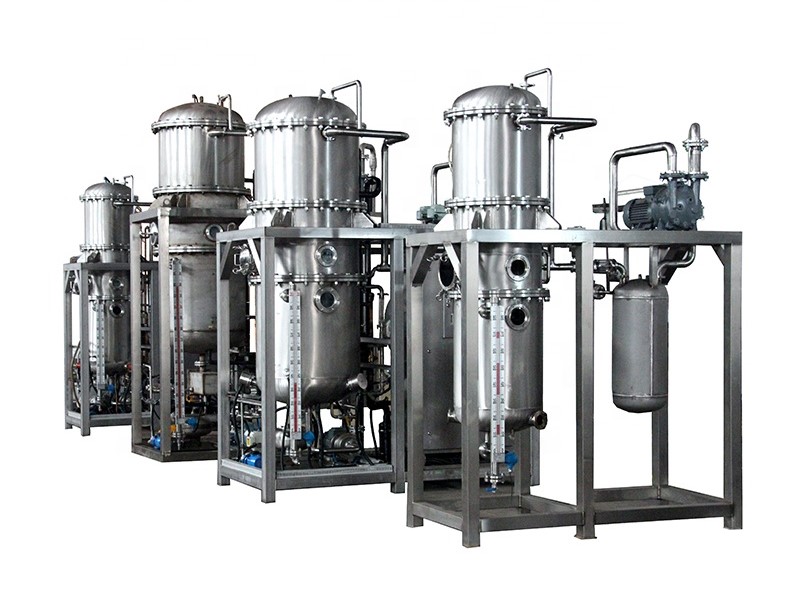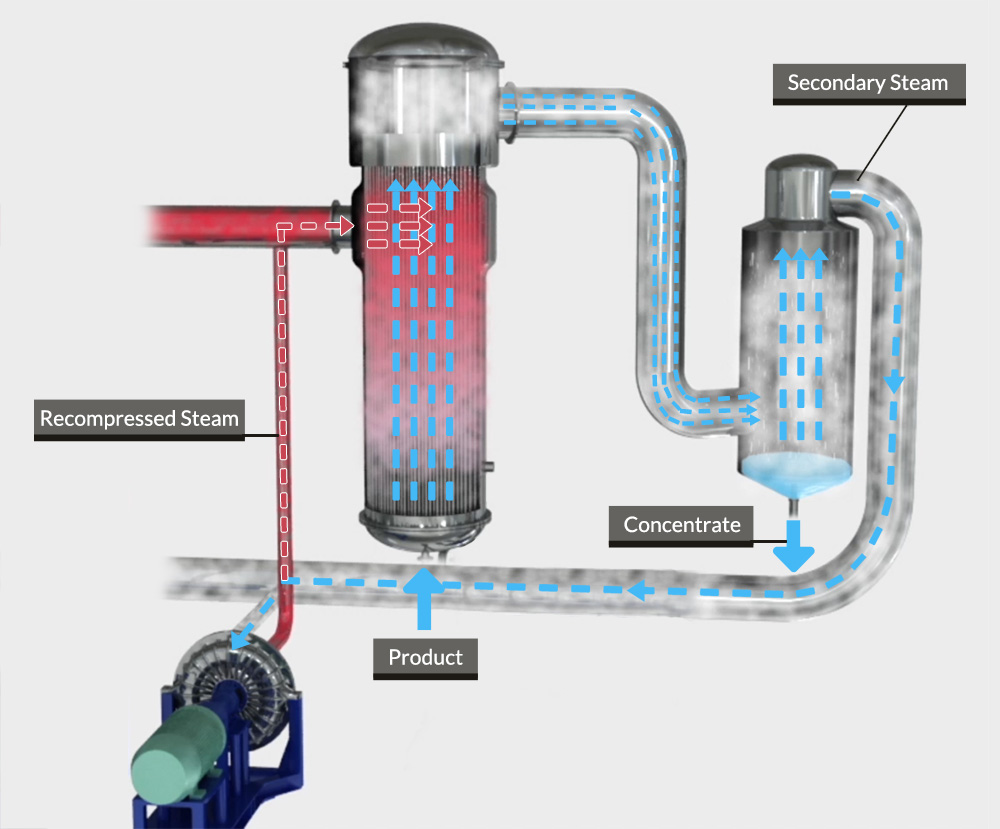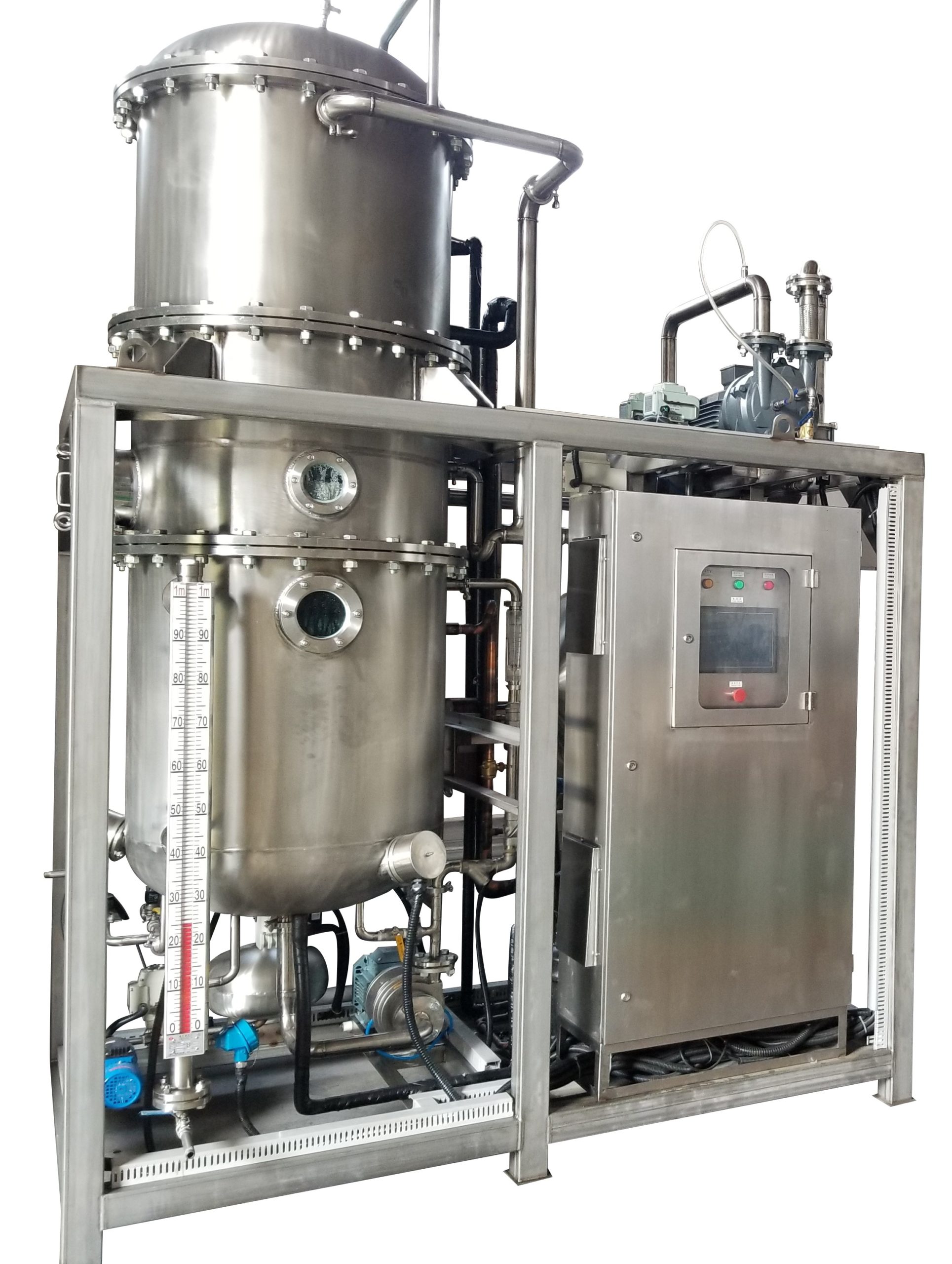Description
A rising film or vertical long tube evaporator is a type of evaporator that is essentially a vertical shell and tube heat exchanger. The liquid being evaporated is fed from the bottom into long tubes and heated with steam condensing on the outside of the tube from the shell side. This is to produce steam and vapor within the tube bringing the liquid inside to a boil. The vapor produced then presses the liquid against the walls of the tubes and causes the ascending force of this liquid. As more vapor is formed, the center of the tube will have a higher velocity which forces the remaining liquid against the tube wall forming a thin film which moves upwards. This phenomenon of the rising film gives the evaporator its name.
Applications:
There is a wide range of applications for rising tube evaporators, including effluent treatment, production of polymers, food production, thermal desalination, pharmaceuticals, and solvent recovery. Aschner, F.S. & Schaal, M. & Hasson, D. (1971). “Large Long-Tube Evaporators for Seawater Distillation. In terms of applications within these industries, rising tube evaporators are mainly used as reboilers for distillation columns, or as pre-concentrators or flash evaporators or pre-heaters designed to remove volatile components prior to stripping.
Thermal desalination:
A specific application of rising tube evaporators is the thermal desalination of sea water. Sea water is pumped into the long tubes of the evaporator while the heating media (usually steam) heats it up. As vapor forms inside the tubes it flows upwards. This evaporation occurs under vacuum conditions that allow for the use of lower temperatures.
Juice concentration and food processing:
The food industry requires handling of delicate products that are sensitive to high temperature for long periods of time. Rising film evaporators can operate quickly and efficiently enough to avoid having to expose the product to high temperatures which may damage or undermine its quality. Hence, they are suitable to use as concentrators for juices, milk and other dairy products which are products that require delicate handling in the food industry.
Advantages and limitations
Low residence time
The main advantage of the rising film evaporator is the low residence time of the liquid feed in the evaporator compared to other evaporator designs like plate-type evaporators. This is crucial because it allows the usage of the evaporator in higher operating temperatures and gives assurance of high product quality despite the product being heat sensitive. Additional advantage is the availability of the option to operate the evaporator as a continuous process which is overall more energy and time efficient than a batch process operation.
High heat transfer coefficients:
Another significant advantage is the relatively high heat transfer coefficient of this evaporator type. This is essential as it reduces the overall heat transfer area requirement which in turn will lower the initial capital cost of the evaporator. This is accentuated by the fact that the components, which consist of a shell and tubes, are easily obtainable with customized designs making them cost effective for construction and ideal for simple evaporation requirements.
Moreover, this type of evaporator also can easily contain those widely available vapor separators for foaming products.
Low efficiency
While the rising film evaporators are relatively efficient and have a several advantages, some literature suggests that they are not as efficient as the vertical or the horizontal tube falling film evaporator. As such, in recent times falling film evaporators are usually chosen in place of rising film evaporators because they have similar advantages as rising film evaporators and have the additional benefits of better efficiency. Moreover, rising film evaporators requires a driving force to move the film against gravity and this causes a limitation because there is a requirement for a sufficient temperature difference between the heating surfaces to provide the driving force.
Limited product versatility:
Another major limitation of rising film evaporators is the requirement for the products to be of low viscosity and have minimal fouling tendencies. Competitive process designs like plate-type evaporators can handle liquids that are more viscous with higher fouling tendencies because the inner parts are more easily accessible for cleaning and maintenance.
Heat transfer coefficients
For a rising film evaporator, the main paths of heat transfer are conduction and convection. These occur as the steam in the shell side heats up the tube and as the tube heats up the liquid and vapor within. The design of the long vertical tubes in rising tube evaporators promote the formation of the long, thin and continual film of liquid formed by the pressure exerted by the vapor which occupies the center part of the tube and rises up. This ascending motion of film and vapor in the center promotes great turbulence which then allows for higher heat transfer coefficients leading to a better efficiency heat transfer. Another significant factor that affects the value of the heat transfer coefficients is the design of the evaporator.
Log mean temperature difference
According to the laws of heat transfer, initially the heat transfer rate increases as the temperature difference increases to approach the boiling point of the materials in the case of a constant feed flow rate. Hence, it is generally good to have a large temperature difference for this process. However, as the vapor bubbles gradually fill the entire center of the tube, the steam pressure reaches a peak value. Beyond this point, the temperature difference, which acts as the main driving force for the heat transfer and also the rising film, will start reducing if there is any increase in steam pressure. In addition to that, there are other constraints in terms of the product quality and consistency when considering increasing the temperature difference. The temperature difference for driving force is also defined heavily by the properties of steam and the boiling liquid.
Overall heat transfer area
This is the total contact area between the heating media and the liquid requiring the heating or any intermediate surfaces in between them. In the case of the rising film evaporator this is the specific region between the film and the surface of long tubes and also the surrounding heating media within the shell of the evaporator. As shown in the equation, the heat transfer area is one of the chief factors that affect the rate of conductive heat transfer. Therefore, it would be favorable to maximize the amount of area available for heat transfer. The limitations for these can be in terms of the cost per unit area as increasing the area would mean increasing the length of the tubes and also the shell of the evaporator which can significantly increase the cost of construction and maintenance.
Residence time
Residence time indicates the time taken for the product to undergo the entire procedure. This can be generalized to mean residence time of a product, which specifies the mean time of the product stays within the evaporator. In many industries, especially for food and beverage manufacturing, clients’ requirement would greatly limit the residence time to be as short to minimize the potential destruction of nutrients through exposure to intense heat.
This can be solved in various ways such as having a pre-heating system prior to the main evaporator with the function of heating the liquid feed until the temperature almost approaches the boiling point. This will lower the load capacity of evaporator and reduce the residence time.




Reviews
There are no reviews yet.